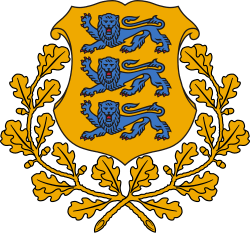Ants Piip
Ants Piip VR III/1 (28 February [O.S. 16 February] 1884 in Tuhalaane[1] – 1 October 1942 in Nyrobsky camp) was an Estonian lawyer, diplomat and politician.
Ants Piip | |
|---|---|
 | |
| 1st State Elder of Estonia | |
| In office 20 December 1920 – 25 January 1921 | |
| Preceded by | himself as Prime Minister |
| Succeeded by | Konstantin Päts |
| 5th Prime Minister of Estonia | |
| In office 26 October 1920 – 20 December 1920 | |
| Preceded by | Jaan Tõnisson |
| Succeeded by | himself as State Elder |
| Personal details | |
| Born | 28 February 1884 Tuhalaane, Kreis Fellin, Governorate of Livonia, Russian Empire |
| Died | 1 October 1942 (aged 58) Nyrobsky camp, Molotov Oblast, Soviet Union |
| Nationality | Estonian |
| Political party | Estonian Labour Party, later none |
| Profession | lawyer, diplomat, politician |
Education
Piip studied at the Teachers' Seminar in Kuldīga (formerly Goldingen), now in Latvia. In 1903–1905, he was a parish clerk and schoolteacher at Alūksne, also a teacher in the Emperor Nikolai Greek Orthodox Parish School in Kuressaare in 1905–1906, in the Kuressaare Marine School in 1906–1912, and in the Janson Merchant School in Saint Petersburg in 1913–1915. He took his high school exams at the Kuressaare State High School, studied at the law department of the Saint Petersburg University in 1908–1913, took additional courses in the Berlin University in 1912, received a scientific scholarship from the Saint Petersburg University in 1913–1916.
Career
Piip was a member of the Estonian Province Assembly (Estonian: Maapäev), and later a member of the Constituent Assembly (Asutav Kogu), and after that, of the Riigikogu. In 1917–1919, Piip was a member of the Estonian Foreign Mission in Saint Petersburg and in London, he participated in the Paris Peace Conference. In 1919 he was Deputy to the Minister of Foreign Affairs, 1919–1920 Member of the Estonian delegation in the Tartu peace negotiations between Estonia and the Russian SFSR. In 1919–1940 he was Professor of International Law in Tartu University. In 1920, he was the diplomatic representative the Republic of Estonia in Great Britain. 1920–1921, while Head of State, Piip was also the Minister of War. He held position of Minister of Foreign Affairs five times, also he was in 1923–1925 the Envoy of Estonia to the United States of America. During 1938–1940, Piip was also member of the Riigivolikogu (first chamber of the Riigikogu).
Piip was arrested by the NKVD on 30 June 1941 and he died in a Soviet prison camp NyrobLag the next year.
Awards
- 1920 – Cross of Liberty III/I
- 1926 – Order of the Three Stars I (Latvia)
- 1932 – Order of the Estonian Red Cross I/II
- 1934 – Order of the Cross of the Eagle I
- 1940 – Order of the White Star I
References
| Wikimedia Commons has media related to Ants Piip. |
- Ants Piip
- Ülo Kaevats et al. 2000. Eesti Entsüklopeedia, volume 14. Tallinn: Eesti Entsüklopeediakirjastus, ISBN 9985-70-064-3
- "Ants Piibu sünd" (in Estonian). Histrodamus. Retrieved 8 June 2013.
| Preceded by Jaan Tõnisson |
Prime Minister of Estonia 1920 |
Succeeded by State Elder of Estonia |
| Preceded by Prime Minister of Estonia |
State Elder of Estonia 1920–1921 |
Succeeded by Konstantin Päts |
| Preceded by Aleksander Tõnisson |
Minister of War 1920–1921 |
Succeeded by Jaan Soots |
| Preceded by Jaan Poska |
Minister of Foreign Affairs 1919 |
Succeeded by Ado Birk |
| Preceded by Otto Strandman |
Minister of Foreign Affairs 1921–1922 |
Succeeded by Aleksander Hellat |
| Preceded by Kaarel Robert Pusta |
Minister of Foreign Affairs 1925–1926 |
Succeeded by Friedrich Akel |
| Preceded by August Rei |
Minister of Foreign Affairs 1933 |
Succeeded by Julius Seljamaa |
| Preceded by Karl Selter |
Minister of Foreign Affairs 1939–1940 |
Succeeded by August Rei (in exile) |
